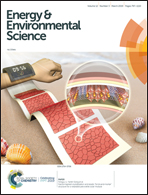A top-down strategy identifying molecular phase stabilizers to overcome microstructure instabilities in organic solar cells†
Abstract
The operational stability of organic solar cells (OSCs) is the essential barrier to commercialization. Compared to thermally-induced degradation, photo-stability of OSCs is far away from being resolved. Here, we demonstrate that the thermal- and photo-degradation of metastable bulk-heterojunction OSCs are governed by the same mechanism. Understanding the fundamental principles behind this mechanism is of significant importance to fully address the instability issues. Structural incompatibilities between the donor and acceptor molecules are identified as the main origin of the instability. Further, we introduce a top-down approach mainly based on their melting temperature and interaction parameters to rationally screen molecular phase stabilizers from a database with more than 10 000 small molecules. Eventually, five chemicals were selected to validate our concept and tested in unstable organic solar cells. 1,4-Piperazine, which possesses a high melting point, good miscibility with polymers and the capability of forming inter-molecular hydrogen bonding, can indeed stabilize the mixed amorphous phases, leading to significantly improved stability of otherwise metastable OSCs.



 Please wait while we load your content...
Please wait while we load your content...